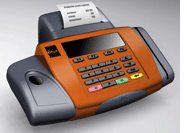 By Andy Williams, Contributing Editor
By Andy Williams, Contributing Editor
More student choices, more options, and peace of mind for their parents are some of the ideas that went into the development of iMye, Sodexho’s new method of paying for food on or off campus. Oh yes, there’s also the “coolness” factor.
“You don’t need a card or cash, just your finger,” said Ric Rocca, senior vice president of strategy for Sodexho Education Services, of the company’s finger scan technology.
Even the name, “iMye” tracks the idea behind the program: In explaining the genesis of its name, the company explains “I Am Me…My Choices are Mine.”
Said Mr. Rocca: “The name was developed internally and reflects the Millennium Student. They’re individuals. It’s a combination of ‘me’ and ‘my,’ a reflection fo how they view music. They don’t buy albums anymore, just individual music and they want more variety and flexibility in terms of where they’re eating.”
The program - in a pilot stage right now - is at two colleges: Gonzaga University, Spokane, Wash., and the University of North Texas, Denton, Tex. It allows students and faculty to pay for their meals on campus and at select restaurants off-campus with a simple scan of their finger. Both Gonzaga and UNT were chosen for the pilot “because we have had great support from our clients there and from the Sodexho operational team,” said Mr. Rocca. Sodexho handles food service for an estimated 900 campuses across North America.
Dale Goodwin, PR director at Gonzaga, reported that early indications suggest that the system seems to be a success from the student perspective said the “students like it, from what I hear.”
Storing scans not fingerprints to protect privacy
First thing Sodexho wants to make clear is that it’s a “finger scan” not a “fingerprint.” In other words, the actual fingerprint is never stored in the centralized database, only algorithms that allow for simple identification.
 “It’s finger scan technology, not a fingerprint, so a record isn’t kept. It uses 16 points which converts the finger scan into algorithmic numbers, rather than the 64 points used for fingerprint comparisons,” said Charles Wesley, Sodexho general manager in Spokane.
“It’s finger scan technology, not a fingerprint, so a record isn’t kept. It uses 16 points which converts the finger scan into algorithmic numbers, rather than the 64 points used for fingerprint comparisons,” said Charles Wesley, Sodexho general manager in Spokane.
“Essentially,” as the web page points out, the finger scan is simply “a batch of numbers, not your fingerprint” that’s kept on file.
Added Mr. Rocca: “The finger scan takes an image of the student’s finger, then we discard the actual fingerprint.” The later finger scan is compared with the algorithm. The finger scan database is stored centrally on a Sodexho computer and transmitted over the Internet.
How the system works: the student perspective
“Students can sign up online or on campus,” said Mr. Rocca. “They can even mail in an application, but to validate the account, they have to put their finger on a finger reader on campus. Everything else can be done online.” That includes loading, or reloading the student’s account.
It’s a prepaid meal plan type account, a debit system, added Mr. Rocca. “It allows them to go to participating retailers around campus and outlets (off-campus) which have finger scan technology right next to the cash register. Students (or parents) can set up the account for automatic reloads or buy a meal plan. They get dollar for dollar.” In other words, there is no cost to the students.
“This university (Gonzaga) was interested in being part of the pilot program, on the cutting edge,” said Mr. Wesley. “The school is pleased with the ability of the program to offer students a prepaid account to spend on and off campus.”
Mr. Rocca, who heads up iMye, said one of the main concepts that led to its development was that “we’re always looking for ways to better satisfy our clients, our customers. Students want choices and we always try to give them that.”
He said students “like the technology associated with biometrics. They’re comfortable with it, they like the fact they don’t have to carry a card. We’d been looking at the technology for a while. It’s a safe and convenient way to do the same thing that a card does.”
Sodexho has partnered with Biometric Access, a Texas company that produces the finger scan readers. “It’s a good, solid company,” said Mr. Rocca. “They’re growing and they fit the bill with what we needed for this program.”
How the system works: the merchant perspective
Since Sodexho operates a campus’s foodservice program, the readers cost the college nothing; they’re part of the contract. Off-campus, eventually merchants accepting finger scan technology will have to pay a fee. “There are a variety of ways to supply the readers,” said Mr. Rocca. “They can rent it, lease it or buy it outright, but since iMye is still in the test stage, we’re not charging the merchants right now.”
The finger scanner is about eight inches high, four inches wide and takes up about a 6-by-6-inch square space on the cash register table.
One glitch so far, if it can be called that, is transaction speed. Since the finger scan is compared with a database and is transmitted via the Internet, merchants with dial-up connections could experience longer transaction times. Normally, approval is almost instantaneous.
Merchants and the university also have to make sure their cashiers are properly trained. “Once the right amount of training is in place, you save time at the register,” said Mr. Rocca.
“You have to make sure cashiers know how to complete the transaction with somebody’s finger,” added Mr. Wesley. “With a trained cashier and a customer used to finger scanning, it can be faster than cash or credit card. While the cashier is ringing up the order, the customer has the capability to start the finger scan process.”
Moving from pilots to full-blown programs
The pilots at the two schools were initiated mid-term, in the middle of the normal school year. Just 350 students at Gonzaga (slightly more than five percent of its 6,000 students) signed up and about twice that number participated at UNT, said Mr. Wesley. The smaller numbers, however, gave Sodexho time to explore the feasibility of the program.
“We’re expecting a much higher penetration this fall,” said Mr. Rocca.
The program is also going to expand into other colleges in the Spokane area and possibly at UNT as well. “We’re not going to blow it out just yet. We’re trying to make sure it’s the right thing to do, we’re moving cautiously,” said Mr. Rocca. “We want to grow these test accounts first.”
He said some 20 merchants have signed up in Spokane and “a little less” at UNT. Merchant participation, too, is expected to increase this fall.
“The merchants that we are signing up now are predominately either restaurants or grocery stores,” he said. But that’s likely to change as other types of merchants become interested in the program. That could also lead to different types of purses in the student accounts.
“In the near future the money in the students’ accounts will be segmented into buckets of money … some that can be used only for food, some that can be used for anything, such as bookstores and other non food merchants,” said Mr. Rocca.
“Students seem happy with the program and our clients seem happy,” said Mr. Rocca. “The system works well, kids like the technology, the coolness of it. We’re really excited about it. Bottom line is it gives kids more options, more choices in where and how they eat. And it gives parents the peace of mind that their students are using the money they send them for food.”
Or, as Mr. Wesley pointed out, iMye “is about touching the future.”
Additional resources:
To learn more about iMye on the web, click here.
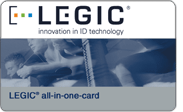 LEGIC provides robust suite of payment and security applications for students in Chur, Switzerland
LEGIC provides robust suite of payment and security applications for students in Chur, Switzerland
By Andy Williams, Contributing Editor
While many U.S. colleges and universities have been hesitant to delve into the contactless world, European and Asian campuses have taken the opposite approach. So it is with the University of Technology and Economics (HTW Chur) in Chur, Switzerland. The college opted for a contactless campus card system based on chips supplied by LEGIC Identsystems Ltd., also based in Switzerland. The company specializes in the design and manufacture of 13.56 MHz contactless smart card technology, including ISO 15693 and ISO 14443 compliant read/write chip sets, security modules, and transponder chips.
HTW Chur specializes in high tech pursuits, so what better way to emphasize your philosophy than to offer your students and faculty a cutting edge, cashless … and contactless … environment?
 The range of courses offered by the HTW Chur covers six degree and three postgraduate courses, two Executive Masters of Business Administration and a wide-range of training courses. The college, according to LEGIC, specializes in the fields of tourism, entrepreneurship and commerce, telecommunications and electrical engineering, structural engineering and architecture design and computer science.
The range of courses offered by the HTW Chur covers six degree and three postgraduate courses, two Executive Masters of Business Administration and a wide-range of training courses. The college, according to LEGIC, specializes in the fields of tourism, entrepreneurship and commerce, telecommunications and electrical engineering, structural engineering and architecture design and computer science.
Two other Swiss companies, EVIS and Kaba, are also involved in the Chur project. EVIS, a LEGIC partner for more than 11 years, provides the project with vending solutions, access control systems, card personalization, hardware/software, cashless payment systems, POS terminals, and time and attendance solutions. Kaba specializes in security technology, such as locking cylinders, security locks, motorized cylinder locks and access control systems.
“We are a basic technology supplier,” said Stephen Neff, LEGIC’s vice president for sales and business development. “We supply transponder chips and people integrate our products into the finished product. Our technology products allow them to make the all-in-one-card system.”
Utilizing this multi-function technology, the university has already issued more than 2,000 cards to students, staff, faculty, and visitors at HTW Chur. The cards serve as the students’ ID, allow access to lockers (where student laptops are typically stored), provide cashless vending and copying, serve as the library card, and enable discounts at off-campus merchants. Museums and theaters also accept the contactless smart card, said Mr. Neff.
The college prints its own cards on site with a card printer from Zebra. This, said Mr. Neff, allows the school to personalize the cards and initialize the chip according to the area in which it will be used.
Payment applications are crucial to campus card success
Students are issued their cards when they enroll. Guests, visitors, and external users of HTW Chur facilities such as the library, can obtain a LEGIC smart card upon payment of a deposit. The student ID is used for payment transactions in the canteens, vending machines, and copiers and printers.
Charging stations - one in each of the two main buildings - allow students or faculty to add value to their card’s e-purse with up to 300 Swiss francs (about US$240). “The student simply presents his contactless smart card to the charging station,” says Mr. Neff, “inserts the money he/she wants to load on the card and after a few seconds the loading station confirms that the card has been recharged.”
“One of the main advantages of this system,” said Mr. Neff, ” is that students only have to bring cash to school if they plan to recharge their electronic purse. They don’t need cash for vending machines, the canteen, or copying machines.”
When funds are spent - via vending or in the canteen - the transaction is forwarded to a central server via the campus’ existing network. Thanks to the TCP/IP networking of all reading units, the card balances can be checked and (lost or stolen) cards can be blocked immediately if necessary.
“The balance is not stored in a back end system,” said Mr. Neff. “The money is in the possession of the cardholder only. This increases the security and the confidence in the system.”
 Physical security complements the financial offering …
Physical security complements the financial offering …
Kaba technology is used for access control and the locks on the 800 lockers. EVIS provides the vending solutions, added Mr. Neff. Since it is a contactless card, a student need only tap his card against the locker’s lock to open it.
While dormitory access is possible using the system, HTW Chur doesn’t need that capability because it is a commuter school, said Mr. Neff. But the campus does have plans to expand the access control capabilities of the system. In the near future, officials plan to deploy locking systems on individual laboratory doors to guarantee greater security and convenience for the user.
One of the benefits of this particular LEGIC technology, the all-in-one-card, is that more applications and functional areas can be added later as the college’s needs progress.
Mr. Neff provides the following example: “… a Chinese university, with more than100,000 LEGIC student cards, installed readers in dormitory showers that turn off the water automatically when the student takes his card away from the waterproof reader in order to save water and money. (Others have added) parking access or access to fitness centers.”
“(HTW Chur) is very satisfied with the new all-in-one-card solution,” said Mr. Neff. “The whole process is much easier and the students profit a lot from the increased comfort. Even the complexity for the card administration has been reduced significantly.” And, he added, thanks to the central data administration and the university using its own printers, it can easily administer and replace lost or stolen cards.
Evangelizing contactless technology in the U.S.
LEGIC has installed its campus card solution in many locations in addition to HTW Chur. “There are more then 50 universities in Europe and Asia using the LEGIC contactless smart card technology already and more are opting for this technology every year,” said Mr. Neff.
But, encouraging U.S. institutions to opt for contactless is a challenge. With offices in Chicago, and Dallas, LEGIC is doing what Mr. Neff calls “missionary work. We’re working with campuses, going to suppliers, trying to sell them on using contactless technology.”
In the U.S., LEGIC, which has offices in Chicago, Ill. and Dallas, Tex., is doing what Mr. Neff calls “missionary work. We’re working with campuses, going to suppliers, trying to sell them on using contactless technology.”
Of course, U.S. Government requirements, such as those included in FIPS 201 and the Department of Defense’s Common Access Card, are helping generate contactless demand, he adds. “Four or five years ago, it (contactless) was a non-issue. Now we’re at least getting invitations. It didn’t happen overnight in Europe, either.” Even so, LEGIC currently has some 70 million contactless cards in the field.
Contactless advantages for campus card systems …
He thinks contactless cards would be preferable at universities if, for nothing else, than for ease of maintenance. “Universities tend to incur quite a bit of vandalism (with items such as gum or coins) being stuffed into the slot designed for the contact card. In Canada’s (early) ATMs, the slot was exactly the thickness of a processed cheese slice, (and vandals stuck them in) so they had to make the slot smaller. Contactless is almost vandal-proof which, I think, is its biggest advantage over contact.”
Another big contactless advantage is, of course, its hands-free capability. “You can put your contactless ID badge into your pocket and walk by the reader. With a contact badge, you always have to take the card out of the holder and put it back again,” said Mr. Neff.
Concludes Mr. Neff: “The most important thing for universities is linking access control with vending, restaurant and other applications. They have to be able to run independently of each other so the card becomes the network … you can obtain IT access as well as physical access. The biggest stumbling block is that many people don’t believe it can be done.”
Ten campuses had already purchased the Webfood online dining solution from CBORD this summer, and now add Boston College to the list. The campus will use it to enable online ordering of meals for pickup and delivery and facilitate card-based payments using their CS Gold card system.
Boston College purchases Webfood®
Ithaca, NY—The CBORD Group, Inc. today announced that Boston College (Chestnut Hill, MA) has purchased Webfood®, the company’s online ordering system. The school plans to install the system later this month.
Using Webfood, Boston College faculty and staff members can view the campus’s “Eagle Express” online catering menu and place orders for both pickup and delivery. Patrons can also pay online using CBORD’s CS Gold® system.
Webfood will later be expanded to serve Boston College’s luxury box owners at Alumni Stadium, as well as BC’s Residential Assistants, who can use the system to order food for floor parties and other social activities.
The University of Colorado at Boulder, University of Maryland, University at Albany, University of Connecticut, East Carolina University, University of San Francisco, Western Washington University, Old Dominion University, Virginia Commonwealth University, and Johns Hopkins University have all purchased Webfood this summer as well—showing strong support for the system in the college and university market.
“We are very happy to see these institutions join the Webfood family,” said Peter Krebs, Webfood Product Manager at CBORD. He added, “Boston College’s innovative use of Webfood is a great example of how our customers work with CBORD to expand and improve our products.”
About The CBORD Group
The CBORD Group serves healthcare facilities, colleges and universities, corporations, chain restaurants, supermarkets, and a host of other market segments. CBORD’s products are used in foodservice, catering, nutrition services, campus ID card privilege control, access control and electronic security, housing services, cashless dining, online ordering, and other institution-wide activities. CBORD products and services are used by more than 5,000 organizations in the US, Canada, Europe, South Africa, New Zealand, Australia, and the Middle East.
The CBORD Group was founded in 1975. Today it employs more than 450 professionals. To learn more about CBORD or CBORD’s Webfood solution, visit us at www.cbord.com or www.webfood.com.
 Fee-free checking, online banking, and more have become standard fare
Fee-free checking, online banking, and more have become standard fare
Students, like other customers, are expecting more and more services from their financial institution. And banks are working hard to find attractive offerings and competitive pricing to meet these new demands. Recent research and studies of student banking habits lend insight into this trend.
Don’t charge me for my checking account
Fee-free checking is one method that banks – those on campus or in a college community – are using to attract more student customers.
An article in last year’s Retail Banker International on student banking in the U.S. noted that banks “are turning to fee-free product offerings” to attract more student customers. Some of the larger banks provide free checking services to students only if their parents are already customers. Upon graduation, the student accounts often revert to standard accounts. For example, the article notes that one bank rolls a student’s account over to a basic banking account on the individual’s twenty-fourth birthday. Another, the article adds, automatically reverts its student account to a direct deposit account after five years.
Some banks have no minimum deposit requirements, others, $50 to $100; others have no minimum balance mandates either, according to the Retail Banker International article. One bank offers a fee-free checking account for the first five years as long as there is at least one monthly direct deposit or if the student’s parents have an account there.
Online banking is becoming a “must” for students
Brick and mortar campus branch banks aren’t necessarily the only option for students. Online banking is another viable choice and, according to a recent J.D. Power and Associates study, many bank customers prefer online banking to face-to-face interaction with a teller.
Quoting transaction times that are nearly three times faster than physically visiting a bank, the Power report, 2006 Retail Banking Satisfaction Study, concluded that online banking is the preferred transaction method among many customers.
This first-ever study by J.D. Power focused on performance among the nation’s largest banks, analyzing the retail banking experience from two points of view – customer satisfaction and customer commitment.
It’s no surprise that a customer’s interaction with a bank has the greatest impact on his satisfaction level. Comparing online and in-person transactions, the study found that the average online transaction takes just 2.8 minutes to complete, compared to 7.7 minutes of combined wait and transaction time with a branch teller. Online transactions received the highest marks in terms of satisfaction, even though this type of transaction is still conducted less frequently than the traditional in-person branch transactions.
Online banking also presents “a clear opportunity for banks to differentiate themselves from potential customers,” remarked Jeff Taylor, director of the banking practice at J.D. Power when the study was released. It used to be that free checking helped attract new customers, but 90% of the 12,904 households surveyed for the J.D. Power study reported already having that benefit. A significant majority, 94%, received free online banking and free debit cards.
The second part of the study, commitment, was designed to give banks a better picture of a customer’s revenue potential. Again, customer satisfaction was a major aspect influencing customer commitment to the bank, the study suggests. For example, customers with commitment levels in the top 25% use an average of 3.3 banking services, compared to 2.5 for those in the bottom 25%. Overall, the retail banking industry enjoys a commitment level of 28%, compared to 13%, on average, in other industries measured by J.D. Power.
A host of other services help differentiate one bank’s student offering from another …
There are other carrots banks are using to lure students.
One enticement is a fee-free credit card with low interest rates, which, according to the same article, many banks offer. However, the low APR is like an introductory rate, good for, say, the first six months. At least one bank rewards students with redeemable points on their credit card if they receive good grades. However, the same bank requires an annual student income of at least $8,000.
One bank used overdraft protection to reverse its declining student accounts. It offered an emergency use card good for a one-time refund of an insufficient funds charge, a stop payment fee or a charge for usage of a foreign ATM.
Banks are also getting quite creative in their attempts to attract students. Other programs include linking the bank’s web site to its scholarship program, offering free $1,000 financial aid drawings, tying debit cards to separate accounts for on- and off-campus use and even offering free downloads from iTunes if the student opens an account within a certain time period.
It seems that creativity may key to attracting student accounts but quality service and competitive pricing is still required to keep them as clients.
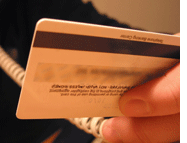 Card systems at colleges and universities have typically centered around on-campus commerce and access. But today, they are extending their reach off-campus and opening their on-campus services to more commerce-savvy students, faculty, and staff. Credit card use has continually increased on college and university campuses, specifically in conjunction with their transaction systems. The companies provisioning campus card program technologies, as well as the universities, find themselves facing greater responsibilities and, more importantly, liabilities.
Card systems at colleges and universities have typically centered around on-campus commerce and access. But today, they are extending their reach off-campus and opening their on-campus services to more commerce-savvy students, faculty, and staff. Credit card use has continually increased on college and university campuses, specifically in conjunction with their transaction systems. The companies provisioning campus card program technologies, as well as the universities, find themselves facing greater responsibilities and, more importantly, liabilities.
In Blackboard’s case, it meant assuring the 400-plus colleges utilizing the company’s Commerce Suite products that cashless transactions – campus card and credit card – are handled in a secure fashion.
That meant making sure Blackboard’s Payment Gateway has been certified as compliant with major card association security programs, such as Visa CISP (Cardholder Information Security Program), MasterCard SDP (Site Data Protection) program, Discover’s DISC (Discover Information Security and Compliance) program and American Express’ Data Security Operating Policies, said Blackboard’s Tom Bell, vice president, industry relations.
 “These programs utilize the Payment Card Industry (PCI) data security standard as the foundation to assess third-party processors,” he added. “This standard ensures that all third-party processes safely and securely store, process, and transmit sensitive credit card data across their network infrastructures. This is the second year that Blackboard has achieved this milestone in the payment card industry.”
“These programs utilize the Payment Card Industry (PCI) data security standard as the foundation to assess third-party processors,” he added. “This standard ensures that all third-party processes safely and securely store, process, and transmit sensitive credit card data across their network infrastructures. This is the second year that Blackboard has achieved this milestone in the payment card industry.”
In short, universities “want to make sure the partner they’re dealing with is compliant and understands the issues,” said Mr. Bell. “We’re very serious about this.”
As more campuses move to a system that deals with people when they’re on- or off-campus, and even online, “we see more issues with dealing with e-commerce or adding funds to accounts … different ways of paying for things. Blackboard has to provide a diverse choice. Years ago, we didn’t have to worry about this,” said Mr. Bell.
“While many third-party processors are not compliant with the PCI standard, Blackboard proactively met this challenge in early 2004 to ensure all credit card transactions originating from our Web Interfaced Card Management Applications were handled in the most secure way possible,” says Mr. Bell. “Our Payment Gateway is a powerful and flexible channel for conducting cardholder-not-present electronic transactions.”
What are the certification benefits?
“Every member along the electronic payment processing channel – from card association (Visa, MasterCard, American Express, Discover) to acquirer to processor to payment gateways down to the merchant level must comply with these standards in order to accept credit card transactions online,” said Mr. Bell. “Our clients must prove to their acquirers that any processor they are affiliated with is complying with the PCI standards. In short, university credit card acquirers must ensure that the university’s credit card processor(s) are complying with the PCI directives in order to maintain compliancy with their higher-ups, the card associations. In addition to embracing the required security standards, Blackboard provides our clients with a level of confidence when they negotiate discount rates with their Merchant Services Provider.”
 Added Russ Palay, Blackboard’s director of e-business and electronic payments: “Visa, MasterCard, etc. mandated it throughout the entire chain … and since we are a third party processor for credit card transactions, we have a responsibility to make sure the credit card data that is transmitted and processed adheres to the card association compliance programs that are bundled under PCI.”
Added Russ Palay, Blackboard’s director of e-business and electronic payments: “Visa, MasterCard, etc. mandated it throughout the entire chain … and since we are a third party processor for credit card transactions, we have a responsibility to make sure the credit card data that is transmitted and processed adheres to the card association compliance programs that are bundled under PCI.”
“What’s driving this is customer demand,” said Ron Dinwiddie, senior director of product development for Blackboard. “Pubic and private colleges and Universities are issuing mandates requiring the highest levels of security when accepting credit cards as a form of tender. We will continue providing our clients with the highest levels of security to protect them and their constituents.”
 By Andy Williams, Contributing Editor
By Andy Williams, Contributing Editor
As the one-year anniversary of The CBORD Group’s acquisition of Diebold’s card systems division approaches, the Ithaca, NY-based company spans the range of colleges and universities – small, medium and now large campuses.
To Bruce Lane, CBORD’s executive vice president, the acquisition was a perfect fit with CBORD’s strategic direction. “Finally the stars aligned to make this happen,” explains Mr. Lane. “I’d been staying in contact with my competitors at Diebold for many years and I kept after them on it.”
“Prior to the acquisition, CBORD had the largest installed base of campus card users in the industry,” said Mr. Lane. “Diebold had larger university customers and that provided us with the need to meet any size campus.” Besides its 650 colleges, mostly in Canada and the U.S., but also in South Africa, New Zealand and Australia, CBORD also has about 200 corporate accounts, including hospitals and companies like Sprint and Daimler Chrysler. CBORD serves between 6 and 7 million cardholders. It is also delving into community colleges.
“We found some beginning synergies that benefited both customer bases,” says Mr. Lane. “Diebold had a very strong core competency in access control. The CS Gold access control product is highly optimized to meet the particular needs of colleges. The product has hundreds of access control installations in colleges. It’s a very powerful, defining product and we’re looking forward to bringing that to our Odyssey customers.”
The $38 million transaction addressed a gap in CBORD’s product line by adding Diebold’s access control and security expertise. The purchase also involved Diebold’s Card System employees migrating to CBORD. Most of them did, a couple didn’t, said Mr. Lane. “There were a lot of great people at Diebold that we are now happy to have as part of the CBORD family.”
Proving to the market that the acquisition makes sense …
CBORD has spent much of the past year proving that the acquisition was good for both companies. “Anytime there’s a change in the players or the marketplace, it’s always reasonable to assume that schools or employees or suppliers are going to get a little nervous. There’s no way to deal with that other than to show it was a good combination,” said Mr. Lane. “Our goal is to make the combined companies as successful as they can be, and to make it viable over the long haul. We’ve worked really hard and made the investment to show the marketplace that it was a logical move.”
For example, he said, CBORD has moved the CS Gold help desk into a new facility in Canton, Ohio. “We’ve also refurbished our training facility in Farmington, New York.”
CS Gold is optimized for large institutions while “Odyssey has a sweet spot among smaller and medium-sized schools,” said Mr. Lane.
“The Gold system is highly desired by institutions that have an IT staff and where the operators are looking for the ability to customize all levels of software for their use. These colleges have the time and resources to get into the system. The Odyssey system accomplishes most of that through user-set parameters where you don’t have to employ a programmer to do it,” he added. Another difference between the two: Odyssey can use a Sybase ASA or Oracle database, while CS Gold is Oracle-based.
“We found that when we were competitors there are customers who want a highly customizable system and others who want a very parameter-driven system,” Mr. Lane added. “(The two products) appeal to very different campus operations. They each have different system architectures. Now either type of customer can find a solution at CBORD.”
Building interfaces and finding shared components
Building an interface between CS Gold and CBORD’s signature Webfood online food ordering system, “was one of first things we did,” said Mr. Lane. Webfood, he said, is now installed in a number of CS Gold schools.
CBORD, he said, also pioneered its campus card users’ ability to use industry-standard POS terminals developed by MICROS Systems. “They’re the largest hospitality POS provider in the world,” said Mr. Lane. “When I started working with them 20 years ago, they were a small company. What’s nice is that now we’re one of MICROS’ largest resellers in the world. That gives our customers better access to service and product enhancements.”
He said Diebold had already begun to install MICROS as a better alternative to making POS terminals themselves. “So use of MICROS was a first, great similarity and point of synergy between the Gold and Odyssey systems.”
He added: “For off-campus programs, a school often takes CBORD card readers and sticks them at off-campus merchants. The readers work off the university’s host. We have hundreds of schools that do that, but we are evolving a new off-campus merchant program, a whole different paradigm to make off campus card use a lot more possible, particularly from a cost perspective.”
Integrating access control into the Odyssey platform
CBORD is also working on integrating Diebold’s access control system into campuses currently using the Odyssey platform. Before acquiring Diebold, CBORD had relied on third-party systems, such as Best, Synergistics and Sensormatic to provide access control solutions to campuses.
“Access control is different because you have to know how to deal with resident students, those on vacation, assigning students various levels of privilege,” said Mr. Lane. “Access control matrixes seem to be lot deeper for universities. They’re not a 9 to 5 operation. The matrix of privileges seems to be more complex for colleges and a lot of off-the-shelf access systems choke on that.”
CBORD is nearly complete with interfacing Diebold’s CS Access, the original native access control part of CS Gold, to the Odyssey platform. However, CBORD will still support third-party access control products if the school doesn’t want to change.
But with CS Access capability, CBORD will no longer have to pass on requests for a one-stop service that includes access control, as the company had to do in the past. “We now have the industry’s best access control system that’s highly tuned to the campus world,” said Mr. Lane. “Some (access control) companies build their systems to work well in a corporate or factory setting, but CS Access is very attuned to the particular needs of the college students and administrators.”
The CS Access portion is not being actively marketed yet. “The development work is done,” said Mr. Lane. “CS Access is battle-proven, Odyssey is battle- proven, so we hope to have it introduced within the next few months.”
The future …
Mr. Lane said he’s been very gratified with the acceptance of this transaction among CBORD’s university clients. “It seems to me the marketplace has accepted the work we’ve done and rewarded us with a number of new accounts,” he said. As to the future: “We have a lot of tricks up our sleeve and cool new things we’re going to be doing. We’ve doubled our development capability (and) we have no plans to do anything but grow. We’re very competitive and we’re very pleased our Gold and Odyssey products are widely accepted in the marketplace.”
 Sure, students are a bank’s reason for its campus existence, but a more profitable client base includes the ones teaching the students … as well as the university administrators and staff. But attracting professors and staff that already have a banking relationship is no easy task.
Sure, students are a bank’s reason for its campus existence, but a more profitable client base includes the ones teaching the students … as well as the university administrators and staff. But attracting professors and staff that already have a banking relationship is no easy task.
Whitney Bright, vice president, Campus Banking, for U.S. Bank, said that while its programs are “tailored to the students rather than faculty and staff in terms of our ability to offer them services, they’re probably twice as profitable as a (typical) student account.” Put another way: “If we can grow faculty and staff, we don’t have to get as many students to justify the expense (of the branch),” she said.
But how do you attract faculty and staff away from their existing banks?
“We’re looking at how to (better) penetrate that market, but we haven’t yet had great success,” said Ms. Bright.
A method that works with new employees is to grab them before they have a chance to select another bank. “Employee orientation is a great way to get them,” says Ms. Bright. But the bank has to have a good in with the human resources department to make that happen. Ms. Bright reports that some universities have let U.S. Bank be part of the employee orientation program.
For existing employees, Ms. Bright suggests that direct deposit service can present an opportunity. “One of things we did with Marquette is help them with their direct deposit campaign,” said Ms. Bright. “Most schools have some kind of direct deposit. Of course, it does help to have a branch on campus. Then it’s more of a push to bank with us and to have direct deposit with us,” she adds.
At Milwaukee, Wisconsin-based Marquette, “everyone who signed up for direct deposit, received $10. The university appreciated our help in supporting (their effort to) increase number of faculty on direct deposit. If one signed up for a new account, the person got $5 and if he also signed up for direct deposit, the total was $15,” said Ms. Bright.
“(At the on campus branch), we can keep a supply of direct deposit authorization forms … which helps the university facilitate that process.”
Finally, there’s always the convenience factor to consider. In many, it’s easier to walk across campus to make that deposit, cash that check, or use an ATM than it is to leave campus to conduct routine banking business. And if the faculty or staff member has an account with the on-campus bank, he or she can save money as well as time by avoiding ATM fees.
The key to penetrating the faculty and staff market seems to a combination of patience, persistence, and creativity. Encourage your bank partner to keep the out in front of the audience and continually refine the message stressing a range of benefits. Not every benefit (e.g. convenience, cost savings, direct deposit) will resonate with every employee … but it is likely that at least one will. The trick is finding that sweet spot for each individual.

Physical security workhorse begins giving way to contactless as price cuts and multi-technology readers eliminate hurdles
By Chris Corum, Executive Editor, AVISIAN Publishing
You can do more – and you can do it more securely – with contactless than you can with proximity. Few would argue with this statement, yet each year proximity technology continues to outsell contactless in the North American security markets. But new products, attractive pricing, and better market education are turning this tide, making contactless the technology of choice for many professionals charged with securing their physical and logical enterprise.
Contactless technologies use the 13.56 MHz frequency to communicate data between the card and reader while proximity technology uses the lower 125 KHz frequency. Contactless can enable read-write and processing capabilities that become increasingly important as additional applications are desired. Proximity cards are traditionally a read-only technology, where a simple identification number is encoded to the card prior to issuance and that data remains static for life. It is this difference that opens up the possibility for a more robust utilization of the contactless card.
According to Erik Larsen, Product Manager of Identity Solutions for Lenel Systems International, smart card technology enables a host of opportunities. “Post-issuance ID number changes and additions, electronic purse and cashless payment functions, biometric storage and authentication, network access and security, and more,” he explains are all made possible.
The processing capabilities of contactless technologies enable the card to ‘participate’ in the security process, authenticating itself to the reader and protecting its owner’s data until it has verified that the reader is legitimate. “On-board processing also secures key components of biometric identification, cashless transactions, and a wide range of other applications,” adds Mr. Larsen.
 So why does prox still dominate in some markets?
So why does prox still dominate in some markets?
With all these inherent advantages of contactless, why do so many security officers and card system managers still opt for proximity solutions? Until now, there have been a number of legitimate reasons for such a decision, though many suggest this is changing.
Price
There has been the issue of price. “Originally it was cost of cards and readers,” says Mr. Larsen, “but those have been addressed.” In fact, in one well-publicized promotion, HID Corp. began offering its contactless cards and readers for the same end-user pricing as its prox offering. According to HID’s product manager for High Frequency Products, Jack Bubany, “the cost for contactless smart cards and readers is comparable with prox and we are working hard to get this word out to the North American market.”
Infrastructure
So if the technology is superior and the price is comparable, what else could be the holdup? As is often the case with new technologies, legacy infrastructure has been a major deterrent for many buyers. The cost and disruption involved with changing out card readers throughout a facility and re-badging the cardholder population has delayed or dismissed many potential migrations during recent years. Says Mr. Larsen, “customers that have a current system in place want to know what is the cost for reissuance and when will the ROI make sense.”
With prior generation equipment, the answer to this question was often met with dismay. But multi-technology readers capable of communicating with both contactless and prox technology are changing the landscape.
Many of the leading security companies are now offering a multi-technology reader. It can significantly ease a transition from prox to contactless by eliminating the need for a mass re-badging effort. New employee cards, replacement cards, and those with need for added security or functionality can be issued the contactless card beginning day one, while other cards are phased in over time or simply allowed to churn via the normal cycle of employee and card turnover.
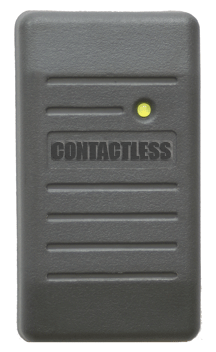 “Even if a company has not made a conscious decision toward a particular contactless smart technology it’s only a matter of time before someone from the IT department asks the security group about their smart card plan,” says Jon Menzel, President and CEO of reader manufacturer XceedID. “If a company has been purchasing Multi-tech readers over time (and used them as simple prox readers) then they will have already invested a substantial amount toward the smart card upgrade without allocating special funds to do so. This greatly reduces the follow on investment to move all cards and readers to contactless technology.”
“Even if a company has not made a conscious decision toward a particular contactless smart technology it’s only a matter of time before someone from the IT department asks the security group about their smart card plan,” says Jon Menzel, President and CEO of reader manufacturer XceedID. “If a company has been purchasing Multi-tech readers over time (and used them as simple prox readers) then they will have already invested a substantial amount toward the smart card upgrade without allocating special funds to do so. This greatly reduces the follow on investment to move all cards and readers to contactless technology.”
But these multi-technology readers are proving to have an important role beyond just a transition-enabler. “Your entire population may not need to go (contactless) smart cards,” explains Mr. Larsen, “or they may not need to go on a first phase deployment. Look at a multi-technology reader for the common areas where both populations need access and then use the 13.56 only at the secure doors.”
“Many large companies are content with their current card populations but have disparate technologies in multiple locations (i.e. HID prox in New York, GE/Casi prox in Los Angeles, and Mifare in London),” explains Mr. Menzel. “… Multi-technology readers function with all of these cards simultaneously saving significant investment dollars required to transition to one card.”
In the past, HID helped clients address the migration from prox to contactless with cards that combined the two technologies, but a new reader provides another alternative. Says Mr. Bubany, “some may see the card as the best migration point and some may see the reader. It depends on the client’s specific environment and needs.”
Education
With the obstacles of price and infrastructure seemingly all but eliminated, what else could delay the move to contactless technology? According to Mr. Larsen, the final hurdle is market education. It seems that while the vendor community has made the transition relatively painless, the buzz has not yet caught up. Say Mr. Larsen, “the general population is thinking it is still too expensive.” Additionally there remains a distinct level of confusion as to the capabilities of contactless technology.
But the end user is not the only community in need of education. “The security reseller and integrator segments need thorough education to ensure they can best help their customers,” adds Mr. Larsen.
Any salesperson will tell you that it is generally easier to sell something you have sold before and know well. This existing comfort level with proximity technology is perhaps the last major hurdle to increased market presence for 13.56 MHz. “The key customer-facing component of this industry is the integrator layer,” says Mr. Menzel, “and they must buy-in to both the benefits of contactless technology and see a reward for selling it over other solutions.”
“At HID we conduct workshops in major cities,” says Mr. Bubany, “one for dealers and one for end users to help them understand what smart card technology offers them. The goal is to give them a level of comfort so that they can feel safe selling the newer technology to clients or implementing it in their organization.”
Next steps
Many suppliers of security components are actively working with resellers and integrators to educate them of the new environment surrounding contactless. As these programs disseminate the information on improved technology, comparable pricing, and stronger security, it seems likely that North America will trend toward contactless technologies … joining the rest of the world’s security markets.
In the next installment of our physical security corner, we will continue this examination of contactless and proximity technologies. Part two of this article focuses on issuance, contrasting the challenges and opportunities that the divergent technologies present to the issuing organization.
 By Chris Corum, Executive Editor, AVISIAN Publications
By Chris Corum, Executive Editor, AVISIAN Publications
A newly-issued patent covering the movement of funds between accounts via the web is hitting close to home with campus card systems. No surprise as the patent was originally conceived to cover these transfers from a bank account to a campus card account.
In November 2005, United States Patent 6,963,857 was issued to JSA Technologies, a familiar name in campus card circles. JSA has been supplying value transfer solutions to colleges and universities since the late 90s. The technology enables web-revalue of campus card declining balance and other accounts.
“We had a working product late 1998,” says Jon Gear, Vice President of JSA, “and the patent was filed in 1999.“ More than six years elapsed between initial application and final approval, a timeframe that is not uncommon in the patent application process.
“It covers the transfer of funds between networks via the Internet,” says Mr. Gear. He stresses that the patent in no way impacts typical bank to bank transactions as these utilize a common financial processing network. It is when transfers occur from this traditional financial processing network into another network that the patent’s coverage seems to begin.
The opening salvo
In recent weeks, letters were sent from JSA to a number of companies and institutions that have developed systems that, according to Mr. Gear, may infringe on the patent. He adds, “we have not told any institution or organization that they are infringing. All we have done to date is (begin) to notify the market that we have this patent.”
Though the actual number of letters was not provided, it was suggested that there was between 10 and 20 parties notified. Campuses using systems supplied by vendors were not contacted, as the vendor would be the point of contact in these instances. “Schools only received the letter if they had a homegrown system,” said Mr. Gear.
What was the purpose of the letter? The intent can be found in the first line of the press release issued March 16, 2006, “Recently JSA Technologies contacted numerous private companies and several institutions of higher education regarding the licensing of a patent invented and commercialized by our company.“
JSA is seeking to license its patented technology. “We don’t want to shut anybody down,” says Mr. Gear, “if you are happy with what you are doing, we don’t want to stop you from doing it. We will just talk about licensing.“
When asked about the fees sought, Mr. Gear told CR80News that they were not yet determined. “It is premature to know what kind of fees would be expected and they will likely be determined on a case-by-case basis. The license fee will probably be negligible in the grand scheme of things.”
According to a company press release issued March 16, 2006, campuses with homegrown systems were contacted because, “we want to grant them licenses to our patent so they may continue their operations.” When asked by CR80News if campuses with in-house solutions developed for their own use prior to the issuance of the patent will be charged license fees, JSA officials stated that they would need a license if they developed the system after 1998 when the patent was filed.
That JSA is seeking license fees should come as no surprise nor should it be met with scorn. The fabric of an entrepreneurial and capitalist society requires protection of intellectual property. The patent is a hard-earned acknowledgement and legal proclamation of intellectual property. And patents are also not cheap. According to the release, JSA has “spent considerable time and resources developing and commercializing its patented software.”
Implications beyond campus cards
Reading the text of the patent, it seems likely that the reach may extend well beyond campus cards. Other financial systems that operate outside of the traditional banking network, but rely on it for revaluing or replenishment, may well be impacted.
Would gift cards architectures that operate within standalone or closed loop networks yet enable web-based value transfers from bank or card accounts be viewed as infringing? What about peer-to-peer payment networks like Paypal that rely on value transfers from bank accounts to fund their online payment service?
Mr. Gear said it was not something he was prepared to comment on suggesting only that, “we would have to have discussions to determine the extent to which these things may apply.”
Dissecting the patent into layman’s terms
We have done our best to translate the morass of ‘patent-speak’ into language that the average non-attorney can understand. The following translation is for the abstract of the JSA patent.
Actual language: The present invention is directed to methods of, and systems for, allowing an account participant to add value via a wide-area network to a first account from a second account. A first account server coupled to a wide-area network supports the first account. In a preferred embodiment the wide-area-network-accessible value transfer station (VTS) includes a central processing unit for executing instructions, and a memory unit. The memory unit includes an operating system, software for receiving from a participant via the network a) second account identification information, and b) a value that the participant desires to transfer to the first account from the second account, second account verification software for receiving the second account identification number from said receiving software and for verifying that the second account authorizes the transfer of the specified value, and value transfer software for receiving a value from the receiving software, for receiving a verification from the verification software, and for transferring the specified value to the first account from the second account if the verification is received. The wide-area-network-accessible VTS further includes conductive interconnects connecting the central processing unit and the memory unit to allow portions of the wide-area-network-accessible value transfer station to communicate and to allow the central processing unit to execute the software in the memory unit.
Translation: The patent is for a system that enables an account holder to transfer funds (or value) from one account to another account via the Internet (or wide area network). The first account operates on a specific network. A value transfer station (VTS) is a computer or similar device with connectivity to that network. The VTS runs software to accept (for the account holder) a second account number and a dollar (or value) amount to be transferred into the first account. The software also (1) verifies that the second account authorizes the transfer (e.g. that sufficient funds or credit are available), (2) receives the electronic transfer of the funds, and (3) adds that value into the second account. The VTS’ CPU and memory are connected such that the CPU can execute the software contained in the memory.
Text of the press release issued by JSA on March 16, 2006:
Recently JSA Technologies contacted numerous private companies and several institutions of higher education regarding the licensing of a patent invented and commercialized by our company. Since that time there has been much debate about the implications of the patent. It is my hope that this communication will address these issues and clarify our intentions regarding the enforcement of the patent.
JSA has been in business since 1998 and has spent considerable time and resources developing and commercializing its patented software. The patent was obtained to protect the business and intellectual property rights of JSA Technologies. Without the patent, companies with greater capital resources could use our invention for their financial gain and attempt to drive JSA Technologies out of business. That is why we sent communications to college and universities who have developed solutions that may infringe upon the patent. We want to grant them licenses to our patent so they may continue their operations.
JSA Technologies was founded on the principal that colleges and universities should be given the opportunity to choose their own path. No one company should be able to dictate what solution is used to satisfy a business objective. We spoke with many institutions frustrated with the limited offerings from their card system provider and developed our unique WebVTS™, StudentLink™ and MerchantLink™ products to address their needs.
We champion the concept of unique solutions and custom designs. That is why it is so important that everyone know our intentions regarding the patent. If JSA cannot meet the business requirements of a given college or university, we do not want to prohibit the institution from finding a solution that does. If, however, the solution uses our patented technology, we will request an appropriate licensing agreement.
We want you to choose JSA Technologies based on the quality of our product and not because we have a patent.
I encourage you to contact JSA if you have any questions or concerns about our patent.
David Johnson
President/CEO
JSA Technologies
(877) 572-8324 x2200
[email protected]
Additional resources:
To visit JSA online, click here.
To read the full text of the patent online, click here.
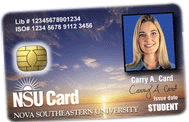 By Andy Williams, Contributing Editor, AVISIAN Publishing
By Andy Williams, Contributing Editor, AVISIAN Publishing
Shackled by an outdated card program and its proprietary operating system, Nova Southeastern University (NSU) went looking for something bigger and better and, more importantly, a campus card that would enable the university to keep pace with technology.
With its 27,000 students, NSU, located in Fort Lauderdale, Florida, is the largest independent higher education institution in the southeast and the seventh largest in the U.S. Founded in 1964, the not-for-profit university has branch campuses in Miami and Dania Beach, with the Dania location housing the Oceanographic Institute, and what NSU calls “student educational centers” in Tampa, Orlando, Miami, West Palm Beach, and Jacksonville, Florida, Las Vegas, Nevada, the Bahamas, Jamaica, and Puerto Rico.
 John K. Brueck, Jr., Nova’s director of Campus Card Services, said it was a “pretty elementary decision” to seek a new card program. “We were handcuffed with our current program. We can’t develop new applications or get new equipment because it’s a proprietary operating system, and it was getting more and more expensive to operate.”
John K. Brueck, Jr., Nova’s director of Campus Card Services, said it was a “pretty elementary decision” to seek a new card program. “We were handcuffed with our current program. We can’t develop new applications or get new equipment because it’s a proprietary operating system, and it was getting more and more expensive to operate.”
 Nova’s current campus card would not have appeared to “outdated” to many observers. It was a smart card with a 1k and 4k chip as well as proximity capability and a magnetic stripe. The system offers physical access to buildings and parking lots on campus, acts as a library card, and functions for a host of payments. “Through the smart chip in a contact environment, users can pay at POS stations, use copiers, pay for print, laundry and vending,” said Mr. Brueck.
Nova’s current campus card would not have appeared to “outdated” to many observers. It was a smart card with a 1k and 4k chip as well as proximity capability and a magnetic stripe. The system offers physical access to buildings and parking lots on campus, acts as a library card, and functions for a host of payments. “Through the smart chip in a contact environment, users can pay at POS stations, use copiers, pay for print, laundry and vending,” said Mr. Brueck.
Replacing the existing smart card system in pursuit of better functionality
But administrators felt constrained by the current system as they found it impossible to add functionality. In addition, they have several different cards –five in all – that are utilized for different functions. That was another reason the college needed change. Administrators wanted a single card – a true one card system.
He said the university “wanted to offer our students superior service. We needed to have a partner that could develop new applications and new opportunities, something that would ease the student experience and positively affect the way students move about campus. It made sense, then, to move to a larger card system that would offer more functionality.”
The college tasked Siemens Corporation, to start exploring what was available and what would work. “Siemens was already established providing infrastructure on our campus,” said Mr. Brueck. That included the college’s security system, including access control and cameras.
“We looked at various vendors based on where we wanted to go with our card program. Siemens identified SmartCentric Technologies International Ltd. as the best fit and reached agreement with the company to provide the smart card system.”
SmartCentric Technologies, based in Ireland, has successfully installed campus card programs, based on its SmartCity system, at about 15 universities, mostly in the U.S., including schools in Orlando and Tallahassee, Florida. SmartCity is a multi-application smart card-based system that includes stored value, loyalty, gift cards, logical access, physical access, biometrics, car parking and ticketing.
“Nova wanted a system that would give them the flexibility to grow their programs,” said SmartCentric’s CEO, Kieran Timmins. “They’re not just buying for today, but tomorrow.”
The partners – Siemens and SmartCentric – also had to take into consideration the university’s “complex requirements,” said Mr. Timmins. “Nova has very diverse campuses … the main one in Fort Lauderdale, one in the Carribean, etc.”
We are working very closely with Siemens,” said Mr. Timmins. “Siemens is on the ground doing project management, requirements analysis, and working with Nova to make sure the networks … the technical architecture is in place.”
Big plans for the new system
Every student – whether at the main campus, in the Bahamas, or in Orlando – receives a student ID card from NSU. However, it depends on what’s available at the specific campus as to what else the card can be used for, said Mr. Brueck.
“The ultimate goal is to take the applications on our south Florida campus, such as pay for print, and grow the applications, where prudent, to extend them to our other campuses,” Mr. Brueck added. “There might not be a need for a meal plan at Las Vegas but you might have web revalue. One of the other things is to have the ability to grow our program outside North America, to be able to do business in different currencies at the cash value stations. For example, the cash revalue stations in Jamaica would accept Jamaican dollars. If we open a campus in Europe, it would accept euros.”
This parallels with what Mr. Timmins says is “the concept behind SmartCity … not every card holder has to have the same profile or even the same size card. In the old days of smart cards, everyone had the same card. Now we can select very precisely who will need what.”
The SmartCity One Card., utilizes both contact and contactless technologies, Nova’s phase one applications will include student, faculty, and staff ID cards; cashless purchases at POS, vending machines, pay for print, meal plans; a web-based card revalue and card holder portal; and access control. The access control portion will incorporate both physical and logical applications and will use biometrics where needed.
 The biometric portions, said Mr. Timmins, will be match-on-card. “When you do biometric authentication, you’re authenticating against the card, not a database.”
The biometric portions, said Mr. Timmins, will be match-on-card. “When you do biometric authentication, you’re authenticating against the card, not a database.”
Mr. Timmins said the new system is planned for early 2007. “There is a significant amount of work that needs to be done, not the least of which is support for the Siemens Card operating system.” Siemens will be supplying the chip and the card, he added, “with SmartCentric supplying the software.”
The card will be a combi-card with prox and an embedded 64 k contact chip from Siemens on the card. “Biometrics (for physical access) can go on either the contact or contactless portion. The contactless portion of the card will support prox technology so the existing investment in prox readers will be maintained,” he added. “We’ll be taking out existing readers on laundry and vending and replacing with our own readers. In the initial phase we’re aiming to replace what they have today: vending, laundry, POS, pay for print.
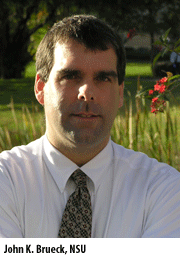
Moving to the future
Web-based revalue will allow cardholders to look at the value on the card and where it was used. There are also plans for logical access, but I’m not sure which phase this will fit into. Next will be e-ticketing and off-campus use. Digital certificates (the ability to digitally sign documents) is also on the list of possibilities.”
“We want to go with single sign on and digital certificates, but whether we move in that direction or not, we’re currently evaluating,” added Mr. Brueck. The card-based digital certificate program would primarily be used at the university’s health care center.
As to moving off campus, it will come, but not right away. “We know we’re going off campus,” said Mr. Brueck. “There’s a lot of interest from retail food establishments with what we’re doing and students want to be able to pay for services off campus. Web revalue will help with that functionality.” That’s one of the reasons the college is planning to place up to four purses on the card.
In the e-ticketing phase, NSU cardholders will be able to pay for event tickets over the Internet and load the ticket to their NSU card, making entry to NSU’s University Center (opening in August) easier on the patron, said Mr. Timmins.
The initial rollout will be 30,000 cards. “We’re going through workshops with them at the moment to determine what will be in phases 1, 2, 3, etc.”
“We’re looking at doing what’s right,” said Mr. Brueck. “We’re taking baby steps. We’re being methodical and not growing beyond our britches too quickly. We feel very comfortable with Siemens and SmartCentric. We look at this as a partnership but also as a family because we’re going to be working very closely with them.”
Additional resources:
To visit the NSU card program on the web, click here.
To visit SmartCentric on the web, click here.

